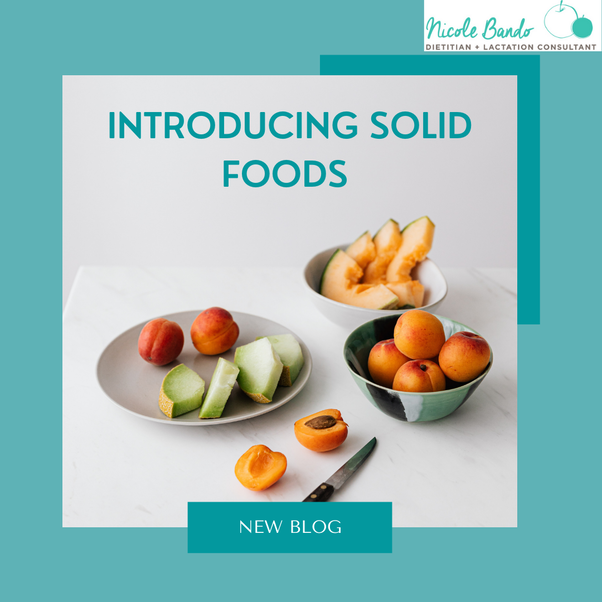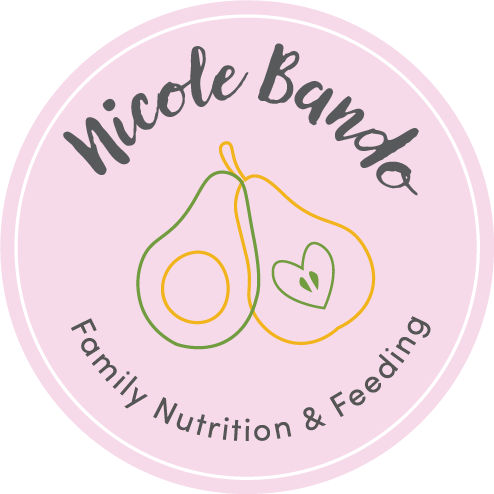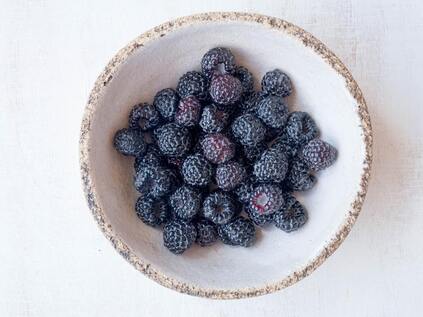
INTRODUCTION TO SOLID FOODS,
By Emma McShane, Dietitian
The World Health Organisation states ‘infants should be exclusively breastfed for six months and after this time continue breastfeeding with appropriate introduction to solids’ (2020).
When breastfeeding is not possible, bottle feeding is recommended.
How do you know if your baby is ready for solid foods?
- Your baby has good head and neck control and can sit upright when supported
- Your baby shows an interest in food e.g. looks at or reaches out for your food
- Your baby opens their mouth when offered food on a spoon
- Your baby has an increased appetite, is feeding more often, and wants more breast milk or formula at the end of their usual feed.
VARIETY OF FOODS:
It is important to include a variety of foods from the five core food groups in your baby’s diet.
CEREAL FOODS
Be sure to offer a variety of grains including wheat, rice, oats and corn.
Example of cereal foods: Bread, crackers, pasta, iron-fortified cereals e.g. Weet-bix, all bran
DAIRY FOODS
Yoghurt, cheese, and cow’s milk on cereal.
Cow’s milk should not be given as a drink (instead of breastmilk or formula), for babies under 12 months of age.
MEAT AND MEAT ALTERNATIVES
Beef, lamb, poultry, well-cooked egg, fish, other seafood, legumes (e.g. lentils and chickpeas)
VEGETABLES AND FRUITS
Can be grated, cooked, pureed or mashed.
Introducing Common allergy causing foods:
- Common allergy causing foods should be included in your baby’s diet before nine months of age, as research has shown that early introduction may reduce the chance of your baby developing a food allergy.
- These common allergy causing foods are: Eggs, Cow’s Milk, Wheat, Soy, Peanut, Tree nuts, Sesame Fish, Shellfish
- It is important to introduce one new allergy causing food at a time, early in the day, and then wait a few days to try another new food, so that you can identify any foods that may cause an allergic reaction.
- An example of how to introduce an allergy causing food, is to mix a small amount (1/4 tsp) of an allergy causing food e.g. hard-boiled egg or smooth peanut butter into your baby’s usual food e.g. vegetable puree. If there are no signs of an allergic reaction (These signs include: hives, welts, swelling of the lips, vomiting, or change in behaviour), then gradually increase the amount next time (1/2 tsp). If your baby does show signs of an allergic reaction, stop offering the food and seek immediate medical attention.
- It is important that once you have introduced these foods, to include these foods in your baby’s meals at least twice a week.
The below is a guide of solids progression, showing texture, quantity and breast/bottle feeds; it may be highly variable for each baby. You may also choose a ‘Baby Led Weaning’ approach, this involves introducing solids through appropriately textured and sized finger foods and allows your baby to explore the food themselves. There is no set way to feed your baby, so do what feels best for your family.
The above is an approximate guide for food quantities and expected number of breast and bottle feeds, this is because there are no set guidelines, as each baby will progress differently. If you feel unsure about how to introduce solids to your baby, a Children’s Dietitian (Paediatric Dietitian) can provide specialised feeding advice.
6 MONTHS
TEXTURES
Coarsely pureed/mashed
QUANTITIES
1-2 tablespoons, twice a day (start with 1 meal and progress to 2 over weeks).
EXPECTED NUMBER OF BREASTFEEDS
Breastmilk is the main nutrition source. Continue breastfeeding on demand.
EXPECTED NUMBER OF BOTTLE FEEDS
If your baby is not breastfed, continue with bottle feeds, as this is still the baby’s main nutrition source. Slight decreases may be seen in the amounts taken.
EXAMPLE OF FOODS
Start with iron-rich foods; as your baby’s iron stores gained during pregnancy start to run low. These foods include fortified baby cereals, eggs, beans, lentils and soft cooked and pureed meat. Introducing allergy causing foods e.g. yoghurt added to pureed fruit and vegetables, Semolina porridge made with breast milk or infant formula.
6-8 MONTHS
TEXTURES
Lumpy, finely chopped, progressing to finger foods
QUANTITIES
Progressing 1-4 tablespoons of food 1-3 times/day by 8 months (slow progression) – up to ½ cup of food
EXPECTED NUMBER OF BREASTFEEDS
On demand
EXPECTED NUMBER OF BOTTLE FEEDS
3-5 times per day at 6-8 months
EXAMPLE OF FOODS
Peanut butter added to mashed foods or porridge, hummus mixed into mashed vegetables, finely shredded, soft meat added to puree vegetables.
8-10 MONTHS
TEXTURES
Grated, diced, chopped finger foods, progressing to regular menu
You’ll find your baby starts to play with their spoon.
QUANTITIES
Up to 1 cup of food at each meal
At 9 months: 3 meals
At around 10 months: Introduce mid-meals, roughly ½ to ¾ cup of food (e.g. ½ cup full fat yoghurt with cut up banana).
EXPECTED NUMBER OF BREASTFEEDS
On demand; By 9 months: 4-5 breastfeeds
EXPECTED NUMBER OF BOTTLE FEEDS
3-4 formula feeds at 9-12 months
EXAMPLE OF FOODS
Well-cooked spiral pasta as finger food, hard-boiled egg with mashed avocado, soft grated cheese as finger food, pikelets.
10-12 MONTHS
TEXTURES
Chopped finger foods, Begins spoon feeding
QUANTITIES
Small balanced meals 3x/day e.g. 1 scrambled egg, chopped soft fruit, 1 Weetbix with cow’s milk, plus mid-meal snacks 1-2x/day.
EXPECTED NUMBER OF BREASTFEEDS
On demand; 3-4 breastfeeds per day
EXPECTED NUMBER OF BOTTLE FEEDS
600mL Bottle feed/day
EXAMPLE OF FOODS
Omelettes, cottage cheese and fruit mixed together, bread offered as toast fingers or sandwiches, homemade fish fingers, pesto sauce with pasta.
1-5 YEARS
Family foods (avoid small, hard pieces of food). Can offer cow’s milk as a drink after 12 months.
Example foods: Scrambled eggs, Crumbed fish, vegetables dipped in hummus, pastas, cereals with cow’s milk
References:
- Australian Breastfeeding Association. Breastfeeding and family foods. ABA, 2020. (Available from: https://www.breastfeeding.asn.au/, accessed May 31st, 2021).
- Australasian Society of Clinical Immunology and Allergy. Introducing foods and allergy prevention fast facts. ASCIA, 2019. (Available from https://www.allergy.org.au/images/pcc/ff/ASCIA_Introducing_Foods_Fast_Facts_2019.pdf, accessed May 31st, 2021).
- NIP Allergies in the Bub. Introducing solid foods. Prevent Allergies, 2018. (Available from https://preventallergies.org.au/introducing-solid-foods/, accessed 31st May 2021).
- NIP Allergies in the Bub. Around 6 months (not before 4 months). Prevent Allergies, 2018). (Available from https://preventallergies.org.au/wp-content/uploads/2020/10/Food-Ideas-for-Babies-around-6-Months.pdf, accessed May 31st 2021).
- NIP Allergies in the Bub. Around 7 to 9 months. Prevent Allergies, 2018. (Available from: https://preventallergies.org.au/wp-content/uploads/2020/06/RECIPE-IDEAS-FOR-BABIES-7-9-MONTHS.pdf, accessed May 31, 2021).
- NIP Allergies in the Bub. Around 10 to 12 months. Prevent Allergies, 2018. (Available from: https://preventallergies.org.au/wp-content/uploads/2020/06/RECIPE-IDEAS-FOR-BABIES-10-12-MONTHS.pdf, accessed May 31, 2021).
- Castle J., Jacobson M. (2013). Fearless Feeding. Jossey Bass. pp 40-54. Accessed May 31, 2021.
- Surwald, D. (2017). Baby-led weaning & introduction of solids. Peninsula Health. Accessed June 10th 2021. Available from: https://www.peninsulahealth.org.au/2017/08/25/baby-led-weaning-introduction-of-solids/



